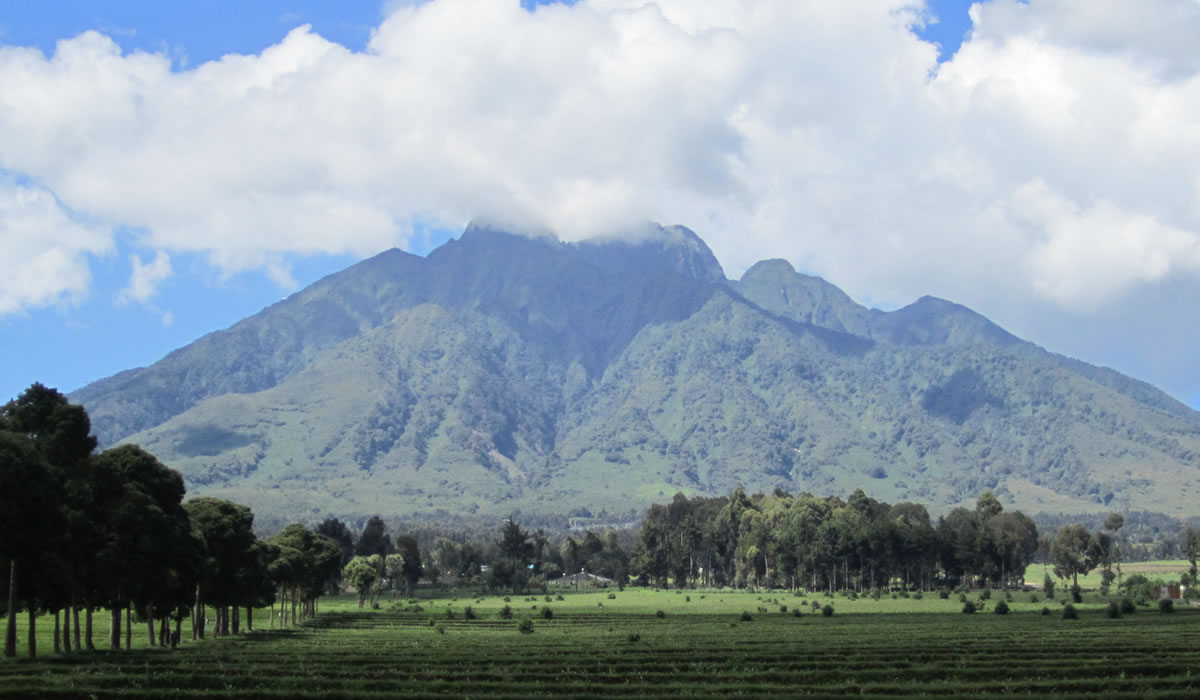Volcano hiking in Rwanda is an awe-inspiring adventure that offers a unique blend of breathtaking natural beauty, rich biodiversity, and cultural heritage. Nestled in the Virunga Mountains, a range of majestic, mist-covered volcanoes straddling the borders of Rwanda, Uganda, and the Democratic Republic of Congo, Rwanda’s volcanoes are part of the Volcanoes National Park. This region provides unparalleled hiking experiences for adventure enthusiasts, nature lovers, and eco-tourists alike. With several peaks to choose from, including Mount Bisoke, Mount Karisimbi, Mount Muhabura, and Mount Gahinga, hikers are guaranteed an unforgettable journey through lush forests, dramatic landscapes, and close encounters with rare wildlife.
This article explores everything you need to know about volcano hiking in Rwanda, from the history and geography of the Virunga Mountains to detailed descriptions of each hiking trail, practical tips for visitors, and insights into the ecological and cultural significance of this volcanic region.

The Virunga Mountains and Volcanoes National Park
The Virunga Mountains, also known as the Virunga Massif, consist of eight major volcanoes, five of which lie within Rwanda’s Volcanoes National Park. These include Mount Karisimbi, Mount Bisoke, Mount Sabyinyo, Mount Muhabura, and Mount Gahinga. The park was established in 1925, making it one of the oldest national parks in Africa. It was initially created to protect the endangered mountain gorillas that inhabit the region, but it has since expanded to promote conservation of the broader ecosystem and provide adventure tourism opportunities like volcano hiking.
The park is located in the northwestern part of Rwanda, about two to three hours’ drive from the capital city, Kigali. The nearest town, Musanze (formerly known as Ruhengeri), serves as the gateway to Volcanoes National Park and is well equipped with accommodations and tour services for hikers and gorilla trekkers alike.
The Virunga volcanoes are part of the Albertine Rift, a section of the East African Rift Valley that is known for its extraordinary biodiversity. The region’s fertile volcanic soil supports dense forests, alpine meadows, and swamps that are home to a wide range of flora and fauna. While the mountains are best known for harboring endangered mountain gorillas, they also provide habitats for golden monkeys, forest elephants, bushbucks, and numerous bird species, many of which are endemic.
Volcano Hiking Trails in Rwanda
-
Mount Bisoke (3711 meters)
Mount Bisoke is one of the most popular volcanoes to hike in Rwanda, thanks to its accessible location and moderately challenging trail. It is an active volcano, although it last erupted in 1957. The highlight of a Bisoke hike is the stunning crater lake at the summit.
The hike starts at Kinigi Park Headquarters and usually takes 6 to 7 hours round trip: 4 hours ascending and 2 to 3 hours descending, depending on fitness levels and weather conditions. The trail leads through bamboo forests, alpine meadows, and montane vegetation. Along the way, hikers may spot golden monkeys, mountain gorillas (though gorilla trekking permits are required for close encounters), and various birds.
The summit offers panoramic views of the crater lake as well as the surrounding Virunga Mountains, and on clear days, hikers can see deep into the neighboring Democratic Republic of Congo.
-
Mount Karisimbi (4507 meters)
Mount Karisimbi is the highest volcano in the Virunga range and the tallest mountain in Rwanda. Standing at 4,507 meters (14,787 feet), Karisimbi offers the most challenging and rewarding hike in the region. Due to its height, the hike is typically a two-day trek with an overnight camp about halfway to the summit.
The hike starts at an elevation of around 2,600 meters and passes through diverse ecological zones, from dense bamboo forests to subalpine and alpine environments. The ascent is steep and strenuous, particularly in the final stretch near the summit, which can be slippery and cold, especially during the rainy season.
The reward for reaching the summit is a spectacular view of the entire Virunga chain and, on a clear morning, the distant volcanoes of Uganda and the DRC. Karisimbi is an ideal challenge for seasoned hikers looking for a multi-day mountain adventure in Rwanda.
-
Mount Muhabura (4127 meters)
Mount Muhabura, also known as Mount Muhavura, translates to “The Guide” because it served as a landmark for travelers in the region. At 4,127 meters, it is the second-highest volcano accessible from Rwanda and is shared with Uganda. The hike is demanding but can be done in one day.
The trail begins at the base in Kinigi and traverses steep slopes covered with grasses, ferns, and occasional patches of forest. Near the summit, hikers are greeted with a small crater lake and sweeping views of the Virunga Mountains, Musanze plains, and even Lake Ruhondo and Lake Burera.
Mount Muhabura’s steep terrain makes the hike challenging, but its relatively low vegetation coverage means the views are more open and dramatic throughout the climb.
-
Mount Gahinga (3474 meters)
Mount Gahinga is the smallest of the accessible volcanoes and is perfect for beginners or those looking for a more relaxed hike. The mountain is located on the Rwanda-Uganda border and rises to 3,474 meters above sea level. The trail meanders through lush bamboo forests that are home to golden monkeys and other wildlife.
At the summit lies a swampy crater that gives the mountain its name “Gahinga” means “pile of stones” in the local language, referring to the lava stones found in the area. The trek usually takes about 6 hours round trip and offers a great introduction to volcano hiking without the physical strain of higher peaks.
-
Mount Sabyinyo (3645 meters)
Mount Sabyinyo is affectionately referred to as “Old Man’s Teeth” due to its jagged summit. While the Rwandan side of Mount Sabyinyo is protected and off-limits to hikers, it is possible to climb the mountain from the Ugandan side. From the peak, hikers can stand at the meeting point of Rwanda, Uganda, and the DRC.
Even though Sabyinyo is not accessible from Rwanda directly, it contributes to the scenic backdrop of the region and is often included in panoramic views from other summits and viewpoints.
Practical Information for Hikers
Best Time to Hike
The best time for volcano hiking in Rwanda is during the dry seasons: from mid-December to early March and from June to September. During these months, trails are less slippery, visibility is better, and rain is minimal. However, temperatures can drop significantly at higher altitudes, especially on overnight hikes like Karisimbi.
Permits and Guides
All hikes within Volcanoes National Park require a permit, which can be arranged through the Rwanda Development Board (RDB) or licensed tour operators. Professional guides are mandatory and are assigned to each group to ensure safety, provide interpretation, and protect the environment.
What to Pack
- Good hiking boots with ankle support
- Rain gear and layered clothing
- Walking stick (often provided by guides)
- Sunscreen, hat, and sunglasses
- Refillable water bottle or hydration pack
- Energy snacks or packed lunch
- Camera (with waterproof covering)
Health and Safety
Hiking at high altitudes can pose risks such as altitude sickness. It is advisable to spend a day acclimatizing in Musanze before attempting high-altitude climbs. Porters are available for hire to assist with gear and improve your hiking comfort.
Ecological and Cultural Significance
The Virunga volcanoes are not only geological wonders, they are vital ecosystems that support endangered species and serve as a source of water, oxygen, and livelihood for surrounding communities. Conservation efforts in the park aim to protect this biodiversity while promoting sustainable tourism.
Volcano hiking also provides economic benefits to local communities through employment and infrastructure development. Many guides, porters, and hospitality workers are from nearby villages, and a portion of park fees is reinvested into community projects such as schools, health clinics, and clean water systems.
Culturally, the region around Volcanoes National Park is rich with history and traditions. Visitors can combine hiking with cultural tours to experience Rwandan dance, music, and storytelling, further enriching their understanding of the area.
Volcano hiking in Rwanda is an exceptional experience that combines physical adventure with deep cultural and ecological insight. Whether you choose a day hike up Mount Bisoke or a challenging two-day ascent of Mount Karisimbi, the rewards are profound: dramatic landscapes, rare wildlife sightings, and the sheer thrill of standing atop an ancient volcano.
In a country often associated with its tragic past, the serene beauty of Rwanda’s mountains tells a different story one of resilience, rebirth, and natural wonder. Volcano hiking is more than a physical journey; it is a connection to the spirit of Rwanda, a land of a thousand hills and endless horizons.

